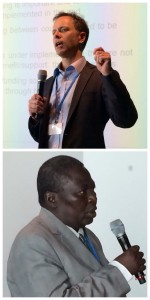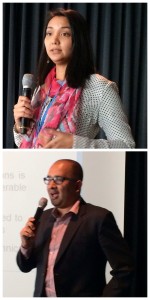



Rapporteurs in today’s eight parallel discussion groups shared the messages that emerged.
Formulating medium-to long-term implementation strategies
- Financial needs assessment at various stages of the NAP process could help identify relevant sources of funding (including private sector) and the mobilization of resources
- Programmatic approaches provide an opportunity to address adaptation through a multi-sectoral, multiple-scale approach, with a longer time-frame and potential for resources optimization
- Programmatic approaches also provide an opportunity for enhanced partnership, catalytic effects, synergies among MEAs and continuous learning
- Piloting adaptation is an effective approach to medium- and long-term adaptation considerations (PACC, NAPA, etc.)
Integrating climate change adaptation in development planning
- High-level commitment and political will is important. Commitment needs to be over the long-term to ensure continuity beyond political mandates;
- Country-ownership at all levels is crucial;
- Countries are making a lot of progress at all levels despite challenges they are facing, and are identifying good practices through learning by doing
Adaptation across scales: temporal and spatial perspectives
Participants from three countries presented their country experiences, including Mozambique’s on integrating bottom-up and top-down approaches, the Philippines’s on models to deliver information to different audiences, and Uganda’s on required temporal skills (for example, what meteorological services are needed for adaptation planning).
- There are various spatial scales in adaptation that range from the local level to the regional level, which can be integrated using a combination of bottom-up (aggregating local, ecosystem plans) and top-down (national priorities, funding coordination) approaches
- Temporal scales are challenging to deal with due to different political/funding/project cycles and uncertainty in climate projections – key consideration here is finding a way to package/communicate/tailor data to particular audiences to allow them to make informed decisions
Regional approaches and NAPs
- A number of regional programmes taking place to support the NAPS process (Pacific / AMCOW Water and Climate Development Programme by GWP-Africa / HIA by WHO). All three representatives presented. Best practices include:
– Establishment of technical facilities and mechanisms and knowledge products
– Pacific climate change round table discussions (strategizing and lesson-sharing)
– Capacity development (trained 96 water-related planners in a period of one year for GWP-Africa Project)
– Standardization of information for national decision-makers
Considerations of gender and vulnerable groups
- Nuanced local level understanding of vulnerabilities is essential while considering gender and vulnerable groups in national planning
- Setting up appropriate institutional arrangements by involving ministries such as gender, children and social protection in NAPs
- Engagement of civil society and faith based organizations is important in considering the concerns of the most vulnerable groups and in encouraging active participation
- Ongoing national assessments such as NatComms need to include issues relating to gender and vulnerable groups
- More clarity needed from the LEG on how the NAP technical guidelines consider gender and vulnerable groups
A focus on agriculture and water sectors
How will the supplements be “piloted”?
- As a tool bag to help build capacity
- Sectoral entry points depends on national priorities
Can the supplements complement/connect to each other?
- Growing list of supplements, growing discussion of nexus approach – challenges but opportunities
- Nexus approach assists in systems thinking and also enables two different ministries to push the same policy (more successful)
- Good to have integrated guidelines, but also good to have separate guidelines
Important for the integration process to build national and/or sector ownership
There is definitely value in the supplements but…
Further work needs to be done in piloting and capacity development
Envisioning a NAP process at the country level
- Stakeholders consultation/analysis is required at various levels depending on the workstream of the NAP process
- Information packaging of the NAP process is important to reach out to targeted stakeholders
- Flexibility and recognition of the country context is essential.
Mobilizing financial and technical support for the process to formulate and implement NAPs
- Ground work and planning is important and take time BUT is only meaningful when implemented in the end
- Opportunities for learning between countries need to be harnessed
- There are many activities under implementation that are not labelled as “NAP” but benefit/support the NAP process
- Practical information on funding sources should be disseminated (potentially through NAP Central)
Posted April 15, 2015 in: Event by admin3


